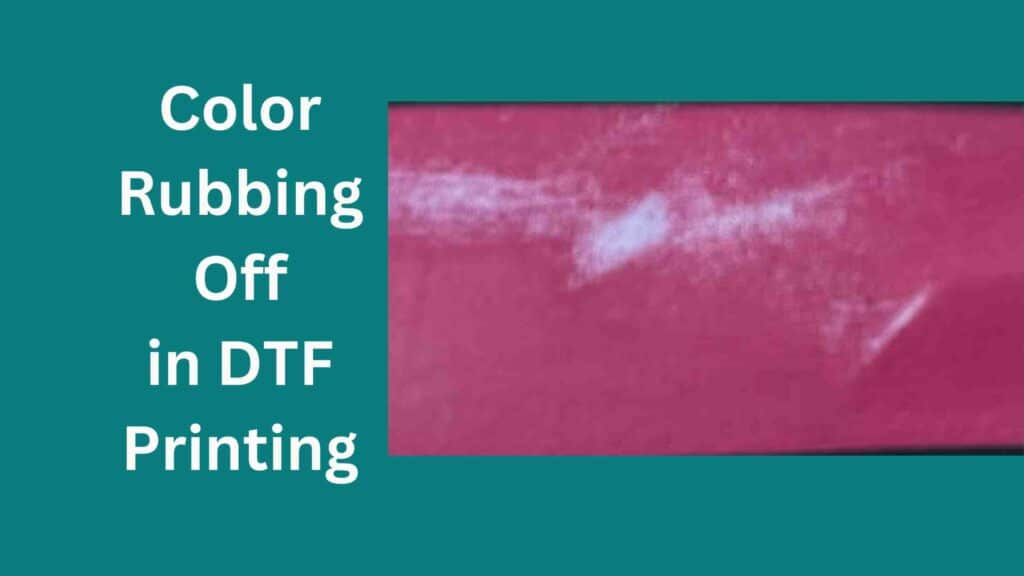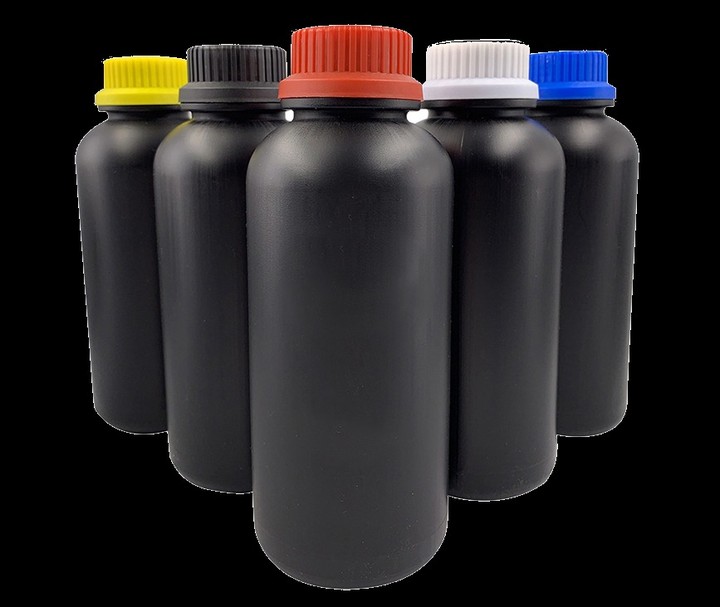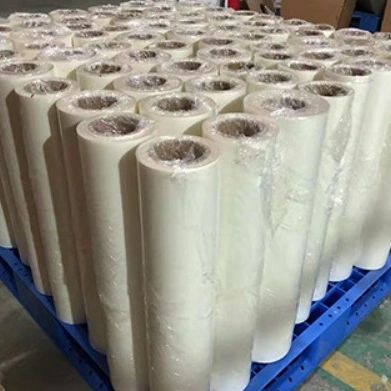Are you frustrated with DTF prints that lose their color soon after printing? Nothing is more discouraging than spending time and money on a design only to have it fall apart quickly. DTF color rubbing off is a prevalent problem. It degrades the quality of your prints, regardless of your experience level with DTF printing. With a little know-how and careful attention to detail, you can avoid color rubbing off and preserve your artwork. In this article, we’ll look at the reasons why colour rubs off in DTF prints. We will also provide solutions to help you stop and repair this annoying issue.

Causes of Color Rubbing off in DTF Prints
Inadequate Curing
DTF prints require adequate curing time to adhere to the fabric or material properly. The ink will not completely set if the print is not given enough time to dry, making it more likely to rub off. This is especially true for white inks, which require a longer curing time than other colors. Humidity, temperature, and ink type impact curing time, so follow the manufacturer’s instructions.
In DTF printing, colour rubbing off can also be caused by DTF ink that hasn’t dried enough. This may happen if the ink is not properly dried at the specified temperature and time. It leads to the ink to only partially adhere to the cloth or substance. Under-curing may be caused by inadequate heating time, wrong temperature settings, or unequal pressure during curing.
It’s crucial to strictly adhere to the manufacturer’s drying time and temperature recommendations if you want to avoid DTF ink that isn’t completely dried. This bonds the ink to the cloth or substrate, preventing colour transfer. Use a heat press with consistent pressure and heat dispersion to fully cure the ink.
In order to avoid any smudging or rubbing off after curing, it’s also crucial to give the product enough time to cool. If the ink hasn’t fully cooled before you touch it, it may still be soft and easy to smudge or rub off.
Incorrect Heat Press Use
DTF printing relies on the heat press, which must be used appropriately to adhere the design. If the pressure, temperature, or timing is wrong, the ink may not completely transfer to the cloth or adhere appropriately, resulting in colour wiping off. DTF printing requires a special heat press and precise pressure and temperature adjustments.
Poor Transfer Film
Transfer film quality affects DTF print longevity. Low-quality or damaged transfer film may not transfer ink to cloth, resulting in partial patterns or colour wearing off. It’s important to choose high-quality DTF transfer film that works with your printer and ink and to check it carefully before using it.
Low-Quality or Incompatible Ink
Using ink that isn’t compatible or is of poor quality will cause colour to rub out while DTF printing. If the inks aren’t suitable, they might not stick well to the transfer film or the fabric. Or, they might not dry right. It’s important to use ink that is made for DTF printing and works with both your printer and your transfer film. Choosing good ink can also help make sure that your drawings stay bright and last for a long time.
How to Fix DTF Color Rubbing off?
Water-based inks are not waterproof until properly cured

Inks that are water-based are often used in DTF printing. But until they are thoroughly cured, they are not waterproof. In other words, if the ink is not completely dried, it may not attach to the cloth or material correctly and could wipe off easily.
It’s crucial to use a heat gun to check the temperature of the heat press. This helps resolve colour rubbing off brought on by inadequately cured water-based inks. By doing this, you can be sure that the heat press is set at the ideal temperature for the ink and material you’re using. After making sure the temperature is right, the shirt can be pressed again at 320F for 1 minute. By doing so, you will know that the ink has properly dried and adhered to the material, preventing it from rubbing off in the future.
Reprinting with proper curing and transfer film
If you’ve already experienced color rubbing off on your DTF prints, don’t worry – you can still fix the issue. Reprinting the design with the right curing and transfer film is one of the easiest solutions for fixing colour rubbing off.
Remove the original print from the cloth or material to begin. After that, make sure you are using the appropriate curing time and temperature for the kind of ink and material you are using. Pay close attention to the manufacturer’s instructions. Use high-quality transfer film that is suitable with your ink and printer to properly transfer the design to the cloth.
Once the new print is done, make sure to fix it properly by giving it the right amount of time and temperature. This will make it more likely that the ink will firmly attach to the cloth and resist rubbing off.
Colour rubbing off can be fixed by reprinting, but it’s crucial to find and solve the source to prevent it from occurring again. You can brilliant, long-lasting DTF prints by paying attention to curing time, transfer film quality, and ink compatibility.
Using a heat press to reapply the design
Another option is to reapply the design using a heat press if the colour on your DTF prints has faded. This is especially helpful if the original print on the fabric or material has only partly worn out or if you are unable to remove it.
Make sure the fabric or material is clean and clear of any dirt or residue before using a heat press to reapply the pattern. After that, position the transfer film over the original design and use the heat press as instructed by the manufacturer to apply heat and pressure. This will help in the ink transfer from the film to the cloth and improve in its firm bonding.
Carefully remove the transfer film after the transfer. Use a heat press to cure the new pattern if required in order to ensure it sticks to the cloth and won’t rub off.
Using a heat press to reapply a design can be a good way to fix colours that are rubbing off. But it’s important to make sure the heat press is set up properly and that the transfer film is of good quality and works with your ink and printer.
Applying a clear adhesive layer over the design to seal it
Another way to stop DTF prints from losing colour is to seal the image with a layer of clear glue. This is especially helpful if the ink did not adhere to the cloth or substance adequately and is the cause of the rubbing off.
Make sure the fabric or material is clean and free of any dirt or residue before applying a clear adhesive coat. After that, cover the whole design with a clear adhesive coat, being careful to get all of the print. Cure the adhesive layer using a heat press or a hot air gun as directed by the manufacturer. This helps in firmly bonding the ink to the cloth or substance and stop colour rubbing off.
After curing, the sticky layer will protect the design and preserve the colours. It’s crucial to choose a transparent adhesive of the highest calibre that is compatible with your printer and ink and to carefully adhere to the manufacturer’s instructions.
To effectively stop colour rubbing off and produce excellent, long-lasting DTF prints, a clear adhesive coating may be applied over the design. To make sure that the new design holds up over time, it’s crucial to identify and fix any underlying problems that may have contributed to the rubbing off in the first place.
How to Prevent DTF Color Rubbing off?
Proper Curing
Proper curing is one of the most crucial elements in avoiding colour rubbing off. Making sure the ink has properly dried and bound to the cloth or substance entails this. It’s crucial to closely adhere to the manufacturer’s suggested time and temperature settings for curing since they might change based on the kind of ink and material being used. To avoid any smearing or rubbing off after curing, it’s also crucial to give yourself enough time to calm down.
Proper Use of a Heat Press
Using a heat press correctly can also help prevent color rubbing off. It’s crucial to check that the heat press’s temperature and pressure settings are appropriate for the particular ink and material being utilised. This will make it more likely that the ink will transfer completely and bind to the cloth or other substance. When applying heat, it’s crucial to do it on a smooth, clean surface to ensure that the pressure is applied uniformly.
Selecting High-Quality Transfer Film

Using transfer film of high quality is essential for avoiding color rubbing off. Poor transfer film may not adequately transfer the ink to the cloth or substance, causing rubbing off. It’s crucial to choose transfer film that has been tested to work with your ink and printer, and to use it according to the manufacturer’s instructions.
Last but not least, selecting suitable, high-quality ink is crucial. Poor ink adherence may cause rubbing off. It’s crucial to choose ink that has been particularly created for DTF printing.
By following these recommendations and employing a heat press, high-quality transfer film, suitable ink, and correct curing, you can make DTF prints that are bright, long-lasting, and resistant to color rubbing off.
Conclusion
In conclusion, color rubbing off in DTF printing may be a frustrating problem. But we can fix it with the appropriate methods and equipment. You can keep your designs brilliant and long-lasting by following the manufacturer’s curing time and temperature requirements, using high-quality transfer film and ink, and utilizing a heat press properly.
FAQs
To avoid color rubbing off, utilize a heat press with equal pressure and heat distribution, high-quality transfer film and ink, and enough cooling time after curing. It’s also important to properly cure the ink to ensure it bonds fully with the fabric or material.
DTF printing color rubbing off is caused by improper curing, improper heat press usage, poor transfer film, unsuitable or low-quality ink, and under-cured DTF ink.
To address color rubbing off, you might reprint with correct curing and transfer film, heat press the design, or seal it with a clear adhesive coating. Use a heat gun to check the heat press temperature. Repress the shirt at 320F for 1 minute for under-cured water-based inks.
No, it’s important to use a heat press with even pressure and heat distribution. This is to ensure proper curing and prevent color rubbing off.

Ashley Wang is a skilled sales manager with knowledge in DTF printing. She presently works for ShenLan Digital, a reputable DTF printer maker. Ashley is the best person to offer advice on selecting the most suitable DTF printer because she has tested a lot of them. She launched DTFPrinterSchool to educate individuals and organizations about DTF printing technology, providing her expertise and observations on the most recent advancements in the sector. Ashley is an invaluable resource for businesses and individuals wishing to invest in DTF printing technology because of her expertise and experience in the industry.
